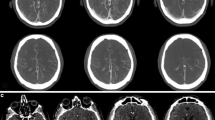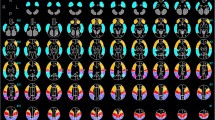Abstract
In this study we aimed to work out a quantitative prognostic index for preoperative assessment of brain technetium-99m hexamethylpropylene amine oxime (HMPAO) single-photon emission tomography (SPET) in patients referred for urgent carotid endarterectomy due to acute obstructive disease of the internal carotid artery (ICA) and neurological deficit. To this end we compared data from preoperative SPET studies with the postinterventional changes in neurological status in 20 patients (17 males, three females; mean age 53 years, SD 4 years) with acute ischaemic cerebral disorders induced by obstruction of the ICA. Carotid obstruction was diagnosed by ultrasound B-mode study. All patients underwent urgent carotid endarterectomy from the ICA. Patients were divided into two groups in accordance with the results of postoperative follow-up: group A comprised patients with significant (more than 3 points) postoperative improvement in neurological condition as quantified by the Canadian Neurological Scale (11 patients); group B consisted of patients with minimal improvement or deterioration (nine, three of whom died). All patients were studied preoperatively by99mTc-HMPAO SPET. The volume of nonperfused tissue (VS, cm3) was quantified using the Mountz technique. Hypoperfused volume (V hypoperf, cm3) in the affected hemisphere was calculated as the total volume of voxels with99mTc-HMPAO uptake <90% of the contralateral symmetric voxels. Discriminant prognostic function was calculated by discriminant analysis as:PF = 0.072×VS + 29.46×(VS/V hypoperf). Patients with preoperativePF values <8.20 demonstrated postoperative improvement in neurological status, while the group withPF>8.90 comprised patients who demonstrated minimal improvement or deterioration. PF values in the range 8.20–8.90 carried an indefinite prognosis. We conclude that the preoperative99mTc-HMPAO SPET can be used for the selection of patients in whom improvement in neurological status may be expected after urgent surgical correction of acute extracranial obstruction of the ICA.
Similar content being viewed by others
References
Ell PJ, Costa DC. The role of nuclear medicine in neurology and psychiatry.Curr Opin Neurol Neurosurg 1992; 5:863–869.
Buell U, Schicha H. Nuclear medicine to image applied pathophysiology: evaluation of reserves by emission computerized tomography.Eur J Nucl Med 1990; 16:129–135.
Fayad PB, Brass LM. Single photon emission computed tomography in cerebrovascular disease.Curr Concepts Cerebravasc Dis Stroke. 1991; 26:712–722.
Hanson SK, Grotta JG, Rhoades H, Tran HD, Lamki L, Barron BJ, Taylor WJ. Value of single photon emission computed tomography in acute stroke therapeutic trials.Stroke 1993; 24:1322–1329.
Maurer AH, Siegel JA, Comerota AJ, Morgan WA, Johnson MH. SPECT quantification of cerebral ischaemia before and after carotid endarterectomy.J Nucl Med 1990; 31:1412–1420.
Nagata S, Fujii K, Matsushima T, Fukui M, Sadoshima S, Kuwabara Y, Abe H. Evaluation of EC-IC bypass for patients with atherosclerotic occlusive cerebrovascular disease: clinical and positron emission tomographic studies.Neural Res 1991; 13:209–216.
Caplan LR, Pessin MS. Symptomatic carotid artery disease and carotid endarterectomy.Annu Rev Med 1988; 39:273–299.
Zubkov YN, Nikiforov BM, Shustin VA. Balloon catheter technique for dilatation of constricted cerebral arteries.Acta Neurochir (Wien) 1984; 70:657–659.
Easton JD, Wilterdink JL. Carotid endarterectomy: trials and tribulations.Ann Neurol 1994; 35:5–17.
Ramsay SC, Yeates MG, Lord RS, Hille N, Yeates P, Eberl S, Reid C, Fernandes V. Use of technetium HMPAO to demonstrate changes in cerebral blood flow reserve following carotid endarterectomy.J Nucl Med 1991; 32:1382–1386.
Cikrit DF, Burt RW, Dalsing MC, Lalka SG, Sawchuk AP, Waymire B, Witt RM. Acetazolamide enhanced single photon emission computed tomography (SPECT) evaluation of cerebral perfusion before and after carotid endarterectomy.J hasc Surg 1992; 15:747–753.
D'Addato M, Pedrini L, Stella A, Pecchi M, Monetti N, Dondi M, Daidone R. Carotid endarterectomy. Pre- and postoperative monitoring with cerebral SPECT.Int Angiol 1988; 7:234–237
Weiss K, Firt P, Hejhal L. Indications for surgical treatment of occlusive disease of the afferent cerebral arteries.Czech Med 1980; 3:206–212.
Ricotta JJ, Ouriel K, Green RM, DeWeese JA. Use of computerized cerebral tomography in selection of patients for elective and urgent carotid endarterectomy.Ann Surg 1985; 202:783–787.
Wilson SE, Mayberg MR, Yatsu F, Weiss DG. Crescendo transient ischaemic attacks: a surgical imperative. Veterans Affairs trialists.J Vase Surg 1993; 17:249–256.
Okada Y, Shima Y, Oki S, Uozumi T. Experimental microsurgical embolectomy after middle cerebral artery embolisation in the dog.Stroke 1983; 58:259–266.
Hacke W Zeumer H, Ferbert A, Bruckmann H, del Zoppo GJ. Intraarterial thrombolytic therapy improves outcome in patients with acute vertebrobasilar occlusive disease.Stroke 1988; 19:1216–1222.
Brott T. Thrombolytic therapy of stroke.Cerebrovasc Brain Metab Rev 1991; 3:911–913.
Overgaard K, Pedersen H, Knudsen JB, Boysen G. Fatal ischaemic brain oedema after unsuccessful thrombolysis.Neurol Res 1990; 12, 81–82.
von Kummer R, Hacke W. Safety and efficacy of intravenous tissue plasminogen activator and heparin in acute middle cerebral artery stroke.Stroke 1992; 23:646–652.
Ueda T, Hatakeyama T, Kumon Y, Sakaki S, Uraoka T. Evaluation of risk of hemorrhagic transformation in local intraarterial thrombolysis in acute ischaemic stroke by initial SPET.Stroke 1994; 25:298–303.
Cote R, Hachinski V, Shurvell BL, Norris JW, Wolfson C. The Canadian Neurological Scale: a preliminary study in acute stroke.Stroke 1986; 17:731–737.
Cote R, Battista RN, Wolfson C, Boucher J, Adam J, Hachinski V. The Canadian Neurological Scale: validation and reliability assessment.Neurology 1989; 39:638–643.
Mountz JM. A method of analysis of SPECT blood flow image data for comparison with computed tomography.Clin Nucl Med 1989; 14:192–196.
Slavin MB. Classified simulation of pathologic processes. Moscow: Meditsina; 1983:343–346.
Rob CG. Operation for acute completed stroke due to thrombosis of the internal carotid artery.Surgery 1969; 65:862–868.
Bauer RB, Meyer JS, Fields WS, Remington R, Macdonald MC, Callen P Joint study of extracranial arterial occlusion. III. Progress reports of controlled study of longterm survival with and without operation.JAMA 1969; 208:509–512.
Diaz FG, Austrian JI, Mehta B, Dujovny P, De los Reyes RA, Pearce J, Patel S. Acute cerebral revascularization.J Neurosurg 1985; 63:200–209.
Selman WR, Crumrine RC, Ricci AJ, LaManna JC, Ratcheson RA, Lust WD Impairment of metabolic recovery with increasing periods of middle cerebral artery occlusion in rats.Stroke 1990; 21:467–471.
Hatfield RH, Gill R, Brazell C. The dose-response relationship and therapeutic window for dizocilpine (MK801) in a rat focal ischaemia model.Eur J Pharmacol 1992; 216:17–24.
Wasterlain CG, Adams LM, Schwartz PH, Hattori H, Sofia RD, Wichmann JK. Posthypoxic treatment with felbamate is neuroprotective in a model of hypoxia-ischaemia.Neurology 1993; 43:2303–2310.
Wise RJ, Bernardi S, Frackowiak RS, Legg NJ, Jones T. Serial observations on the pathophysiology of acute stroke. The transition from ischaemia to infarction as reflected in regional oxygen extraction.Brain 1983; 106:197–222.
Hall ED. The neuroprotective pharmacology of methylprednisolone.J Neurosurg 1992; 76:13–22.
Powers WJ, Grubb RL Jr, Darriet D, Raichle ME. Cerebral blood flow and cerebral metabolic rate of oxygen requirements for cerebral function and viability in humans.J Cereb Blood Flow Metab 1985; 5:600–608.
Pappata S, Fiorelli M, Rommel T, Hartmann A, Dettmers C, Yamaguchi T, Chabriat H, Poline JB, Crouzel C, Di Giamberardino L. PET study of changes in local brain hemodynamics and oxygen metabolism after unilateral middle cerebral artery occlusion.J Cereb Blood Flow Metab 1993; 13:416–424.
Raynaud C, Rancuriel G, Samson Y, Baron JC, Soucy JP, Kieffer E, Cabanis E, Majdalani A, Ricard S, Bardy A, Bourgiuignon M, Syrota A, Lassen N. Pathophysiologic study of chronic infarcts with I-123 isopropyl iodo-amphetamine (IMP): the importance of periinfarct area.Stroke 1987; 18:21–29.
Launes J, Nikkanen P, Lindroth L, Brownell AL, Liewendahl K, Iivanainen M. Brain perfusion defect size in SPET predicts outcome in cerebral infarction.Nucl Med Commun 1989; 10:891–900.
Limburg M, Hijdra A, de Bruine JF, Verbeeten BWJ. rCBF SPECT in brain infarction: when does it predict outcome?J Nucl Med 1991; 32:382–387.
Mountz JM, Modell JG, Foster NL, Du Pree ES, Ackerman RJ, Petry NA, Bluemlein LE, Kuhl DE. Prognostication of recovery following stroke using the comparison of CT and technetium99m HMPAO SPECT.J Nucl Med 1990; 31:61–66.
Tsukuda M, Kuwabara Y, Ichiya Y, Otsuka M, Tahara T, Miyake Y, Mizuguchi M, Gunasekera R, Masuda K. Evaluation of the significance of “redistribution” in I-123 IMP SPECT in cerebrovascular disorders — a comparative study with PET.Eur J Nuel Med 1989; 15:746–749.
Bushnell DL, Gupta S, Mlcoch AG, Barnes WE. Prediction of language and neurologic recovery after cerebral infarction with SPECT imaging usingN-isopropyl-p-(1-123) iodoamphetamine.Arch Neurol 1989; 46:665–669
Bergner R, Sieggreen MY, Lazo A, Hodakowski GT. The silent brain infarct in carotid surgery.J Vasc Surg 1986; 3:442–447.
Mountz JM, Malinoff H, Wilson MW Silent infarction of the brain. Incidental finding demonstrated by SPECT.Clin Nucl Med 1988; 13:498–501.
Seiderer M, Krappel W Moser E, Hahn D, Schmiedek P, Buell U, Kirsch CM, Lissner J. Detection and quantification of chronic cerebrovascular disease: comparison of MR imaging, SPECT, and CT.Radiology 1989; 170:545–548.
Costa DC, Kaboli P, Douli V, Ell PJ. Ceretec brain perfusion: a reference normal file [abstract].Nucl Med Commun 1993; 14:269.
Hartmann A, Tsuda Y, Lagreze H. Effect of hypervolaemic haemodilution of regional cerebral blood flow in patients with acute ischaemic stroke: a controlled study with hydroxyethylstarch.J Neurol 1987; 235:34–38.
Vorstrup S, Andersen A, Juhler M, Brun B, Boysen G. Hemodilution increases cerebral blood flow in acute ischaemic stroke.Stroke 1989; 20:884–889.
Sundt TM, Sandok BA, Whisnant JP Carotid endarterectomy. Complications and preoperative assessment of risk.Mayo Clin Proc 1975; 50:301–306.
de-Dombal FT, Clamp SE, Softley A, Unwin BJ, Staniland JR. Prediction of individual patient prognosis: value of computer-aided systems.Med Decis Making 1986; 6:18–22.
Deckers JW Fioretti P, Brower RW, Baardman T, Beelen A, Simoons ML. Prediction of 1-year outcome after complicated and uncomplicated myocardial infarction: Bayesian analysis of predischarge exercise test results in 300 patients.Am Heart J 1987; 113:90–95.
Edwards FH, Albus RA, Zajtchuk R, Graeber GM, Barry MJ, Rumisek JD, Arishita G. Use of a Bayesian statistical model for risk assessment in coronary artery surgery.Ann Thorac Surg 1988; 45:437–440.
Author information
Authors and Affiliations
Rights and permissions
About this article
Cite this article
Shvera, I.Y., Cherniavsky, A.M., Ussov, W.Y. et al. Application of technetium-99m hexamethylpropylene amine oxime single-photon emission tomography to neurologic prognosis in patients undergoing urgent carotid surgery. Eur J Nucl Med 22, 132–138 (1995). https://doi.org/10.1007/BF00838943
Received:
Revised:
Issue Date:
DOI: https://doi.org/10.1007/BF00838943




